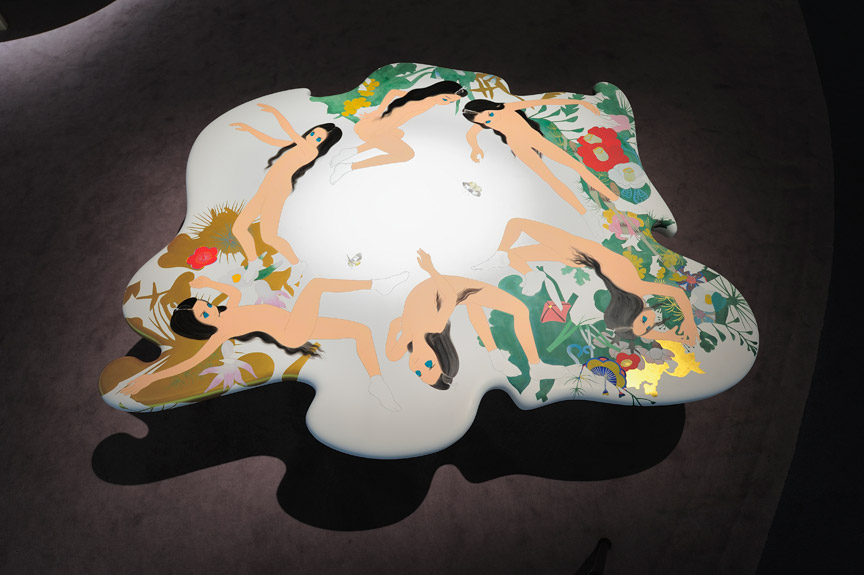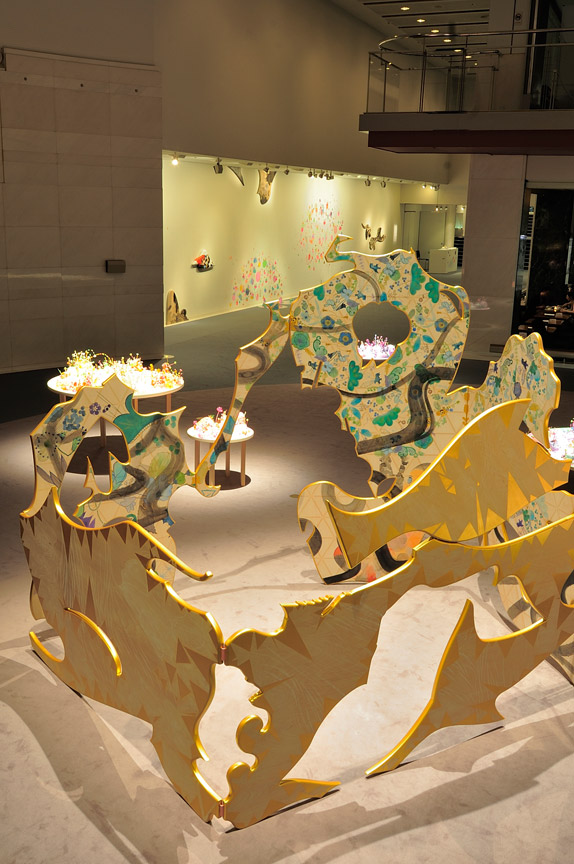Shows
Ai Yamaguchi and Pip & Pop’s “Utakata Tayutau – The Blinking of an Eye”


A recent exhibition at Tokyo’s Spiral Garden demonstrates that cute is not just a Japanese specialty. “Utakata Tayutau– The Blinking of an Eye,” curated by Spiral’s Yoshie Ota, presented an international pairing of Japanese artist Ai Yamaguchi with Australian artist Pip & Pop (Tanya Schultz), who offer two varying approaches to the aesthetic.
This was not the first time that these women’s works were being shown in Japan. Yamaguchi is represented by Tokyo’s veteran contemporary art space Mizuma Art Gallery, while Pip & Pop was a part of the first Aichi Triennale in 2010. However, this is the first time they have been shown together.
Speaking in August in Tokyo, Ota said she sees the artists’ works as distinct from one another, yet the combination is intended to be an experience for the senses that brings femininity, naivety and creativity to the fore. And although it apparently wasn’t the curator’s intention to focus on the theme of “cute,” it was difficult to ignore when viewing such works together. Unfortunately, it still remains difficult to pursue a serious discussion of notions such as “cute,” or the Japanese term kawaii, in terms of art criticism. Even in Japan, a country where many contemporary artists over the past two decades have been utilizing such an aesthetic in their works, critical analysis is generally weak. While many Japanese people can give a description of what kawaii means, definitions differ depending on the person. During an interview in August, for example, Ota described kawaii as a feeling rather than a visual code. According to Ota, as subjective as an audience can be, if a piece can evoke certain feelings of sweetness, vulnerability, playfulness and beauty, it can be kawaii. This definition wholly fits the works found in “Utakata Tayutau.”

Yamaguchi’s art is quite playful: she inserts cute, large-eyed, small-faced, anime-style girls into the typically austere and exclusive world of traditional Japanese painting. Her acrylic paintings with gold details resemble the elegant paintings of the 17th-century Rimpa school. In fact, her work We have as much to talk about as this mountain is tall (2008)—comprising of an assortment of summer flowers, squirrels and girls on a golden background—was just featured in an exhibition celebrating the last official Rimpa artist, Kamisaka Sekka (1866-1942), at Sydney’s Art Gallery of New South Wales. Disrupting this traditional influence is the presence of her signature girl figures, sometimes naked and often reclining across the composition in various languid poses. She paints into her works the fashions of 17th- and 18th-century courtesans, but the figures are expressly pre-adolescent girls, not adult women. The girls are always depicted as passive, and they often settle into the compositions with the docile ease of a flower or forest creature. Michi Sugara (2010) is a painting on wood panel, cut in a freestyle cloud-like shape, which was here presented as a low table standing on the gallery floor. On a white background, some floral patterns (reminiscent of kimono textiles) sit behind six female figures. The rather vulnerable looking girls, without any clothes on except for their white tabi socks, are placed unevenly around the composition to form a kind of decorative pattern. Stylistically, Yamaguchi’s works—made of mostly rich, dark colours carefully applied within the confines of thin, black outlines—are clearly differentiated from the all-encompassing hyper-colored installations of Pip & Pop. Moreover, the Australian artist creates temporary installations. While Yamaguchi’s paintings are collectable, Pip & Pop uses materials with a necessarily limited lifespan. For example, in “Utakata Tayutau,” she created site-specific wall collages of paper circles and stickers as well as tiny worlds created on top of mountains of colored sugar. In the installation, collectively called Love Grows a Flower (2012), low down, at what might intentionally be a child’s eye-level, a detailed assemblage was set on top of an arrangement of sugar in colors ranging from pinks and purples to florescent green and pastel blue. The works, for their boldness in color, immediately attract the viewer, their abounding details holding one’s gaze. Featuring tiny plastic animals standing among forests and mountains made from candies, beads, pipe cleaners and cake decorations, the works looked as though they were created as a form of play. While being full of bright and pure optimism, they were evidently vulnerable to the curious fingers of children or the accidental brush of a passing visitor’s arm or clothing. In this way, both Yamaguchi and Pip & Pop tapped into feelings of sweetness and innocence, on the one hand, as well as a sense of helplessness—all of which is often associated with both cuteness and kawaii.


During our interview in mid-August, Pip & Pop explained that she is often inspired to create tiny scenes of utopia, such as images of the Garden of Eden, legends about lands of plenty such as those from folk tales, or more recent stories like Roald Dahl’s 1964 book Charlie and the Chocolate Factory. Such tales are often coupled with lessons about the dangers of overindulgence. Pip & Pop’s art also responds to both positive and negative aspects; they can be perceived as cute, but can also be interpreted more cynically. Rather, these works seem to sit right at the tipping point: appreciable for being very sweet, yet perhaps too sweet—much like the feeling of having eaten too much cake.
While art is a subjective experience, the combination of works by Ai Yamaguchi and Pip & Pop certainly prompted an overall feeling of sweetness, innocence, playfulness and lush visual beauty, accompanied by a secondary tension lingering between these elements. While the artists’ treatment of cuteness was quite different, together their works created a microcosm that transcends nationality.







